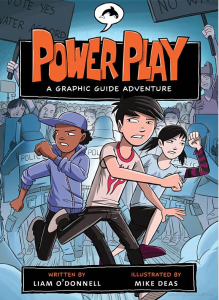When I visit schools or run writing workshops for kids (which I’m doing this spring at the Toronto Public Library), I’m often asked how to get started as a writer.
It used to go something like this:
1. Write a great story.
2. Send it to Publisher.
3. Wait for 1 year.
4. Got published? Yes: go to 5. No go to 1.
5. Hold up Finished Book proudly.
6. Go back to 1.
That’s how it works with my books from traditional publishers, like Tank and Fizz from Orca Book Publishers.
The New Writer’s Typical Day
But now there’s another way. Next time I talk to kids (or teachers!) about what a writer does all day, it’ll be something like this:
1. Write a great story.
2. Hire an editor.
3. Hire a cover designer.
4. Approve the cover and the final manuscript.
5. Jam manuscript into varying formats (epub, mobi, pdf) so it all looks nice.
6. Upload it.
7. Price it.
8. Market it.
9 Go back to 1.
This is what I did this weekend when I published Pixelhead, the latest story in my Tech Tales series for Middle Grade readers.
The second list is definitely longer. It also requires a range of diverse skill sets that go far beyond writing. As I’ve moved into self-publishing books like Ganked and my Tech Tales short stories, I’ve used skills I never knew I had.
New Writing = New Skills
Hiring editors, deciding on covers, wrangling text to look nice are all the domain of the publisher and their army of editors, artists and designers. And while you could argue that the writer becomes the publisher when they self-publish, I still approach this as a writer.
The modern writer needs above all to write a great story (something I hope I do.) But they also, if they wish, have the power to get that story directly to readers.
If they wish to take the path of independent publishing, then the definition of a “writer” changes and so does the job description and the skills needed.
Now, when students ask me about how to get started writing, I tell them about their self-publishing options and writing communities like Wattpad. While I stress the importance of Step 1, I also emphasize that things are changing. The path of tomorrow’s great writers will definitely be different from those writing super stars of today.
Teaching Modern Writing
As an educator, I try to ensure students see themselves and their world in the stuff we learn. Peddling out the myths of a writer’s life does them an injustice. And besides they won’t buy it.
In a tech-filled world of uploads, remixes and user generated content, why should publishing stories be any different?
What do you think? How do you teach your students about being a writer? Let me know in the comments below.
–-
As an award-winning children’s author, gamer-geek and elementary school teacher, I often have Tech Teaching ideas and project news to share with fellow educators. I deliver these resources and ideas to your inbox in my e-newsletter Reading Change.
If this sounds like something you’d like to receive, then subscribe to Reading Change.
You can unsubscribe anytime and I won’t share or sell your data. Honest.
Thanks!
Liam





















